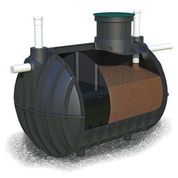Uncategorized
SEPTIC TANK – the solution!
Septic Tanks are a waste water disposal system commonly used when the property is not connected to municipal sewerage.
Septic tanks these days are designed for fast and easy installation with all baffles and fittings pre-installed. There is no need for concrete as the tanks themselves are self-anchoring.
Waste-water tanks are mostly used for underground application with gravity to assist the flow. Most tanks will cater for households, small businesses for anywhere to 1-6 people. A simple solution for more people is to add additional units.
Sewerage tanks can also be used as an above ground sewerage solution also. This will require an after-tank pump to pump out the liquid.
Some of the benefits of the new type of tank are as follows:
- 10 minute hook-up – fittings and baffle are pre-installed
- One-piece tank with lifting lugs – lightweight and easy to handle.
- Australian manufactured – offering you maximum support and service
- Self-anchoring – does not require concrete
- Low profile design – minimal excavation depth
- Tested and certified to AS/NZS 1546.1:2008 – assurance of maximum performance
- EPA approval BMP650823
How it works in lay-man terms.
These on-site waste-water systems use the soil to absorb and naturally treat wastewater flows. Using bacteria to break-down the waste, it is important not to dispose of cleaning products into the drainage system. No chorine, no ammonia, fats and grease nor kitty liter or nappies are to be placed in the unit.
It is normal in the first few weeks of installation that some odors will occur, but as the bacteria starts to work, the odors will disappear.
In respect of ground maintenance, the drainage pipes allow the wastewater to seep into the subsurface soil. Ensure the area over the tank is left undisturbed. It is important to divert excessive stormwater away from this area. Ensure this area is also free from tree roots also.
Installation of your waste-water tank
Before purchasing, ensure you contact your local council and all relevant bodies before digging to ensure you can locate all pre-existing cables and pipes.
Ensure the escavation will not undermine any foundations or structures. Where no regulations exist, the distance is recommended to be a a minimum of 2 times the depth of the excavation.
Excavation slopes need to be a minimum of 30 degrees and the hole depth should be a minimum of 1675 below the pavement level. Install 100mm of sand or crusher dust and compact it to firm and level.
The hole dimensions should be a minimum of 200mm larger than the tank on all sides.
When you are ready, please ensure you follow the instruction manual for the final touches to ensure the correct installation – see link here for full installation.
De-sludge your tank.
De-sludge your Tank – every 3-5 years. The lenght of time to de-sludge will depend on the amount of volume that is put through the tank. Ensure that the tank is pumped out by a licensed liquid waste contractor who is familiar with septic tanks. Be sure to leave a small volume of effluent in the tank to ensure the tank does not float up and to ensure the healthy bacteria levels will continue to be effective.
Your waste-water tank should serve you for many years ahead having a 7yr manufacturers warranty.

